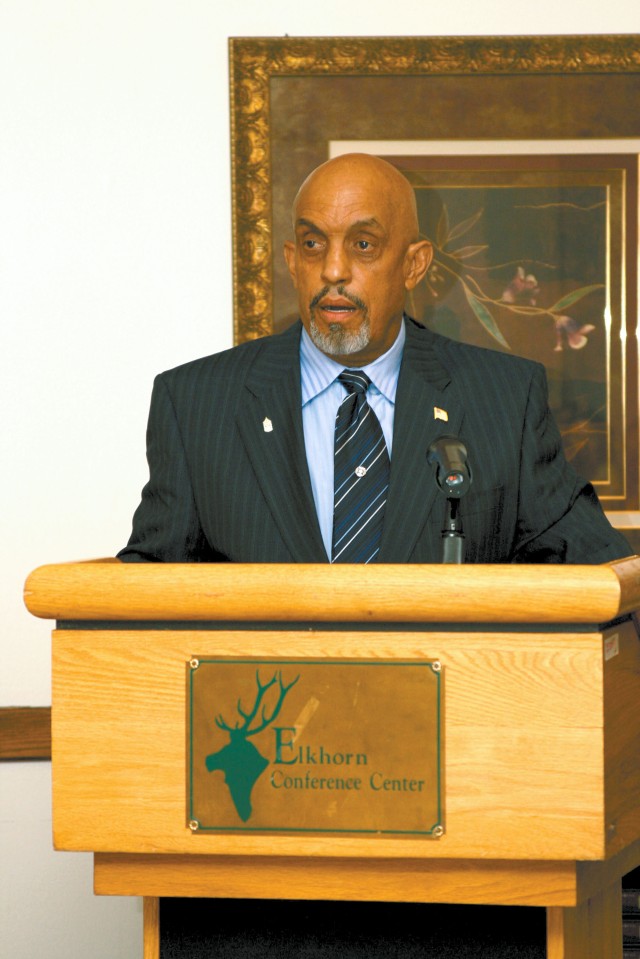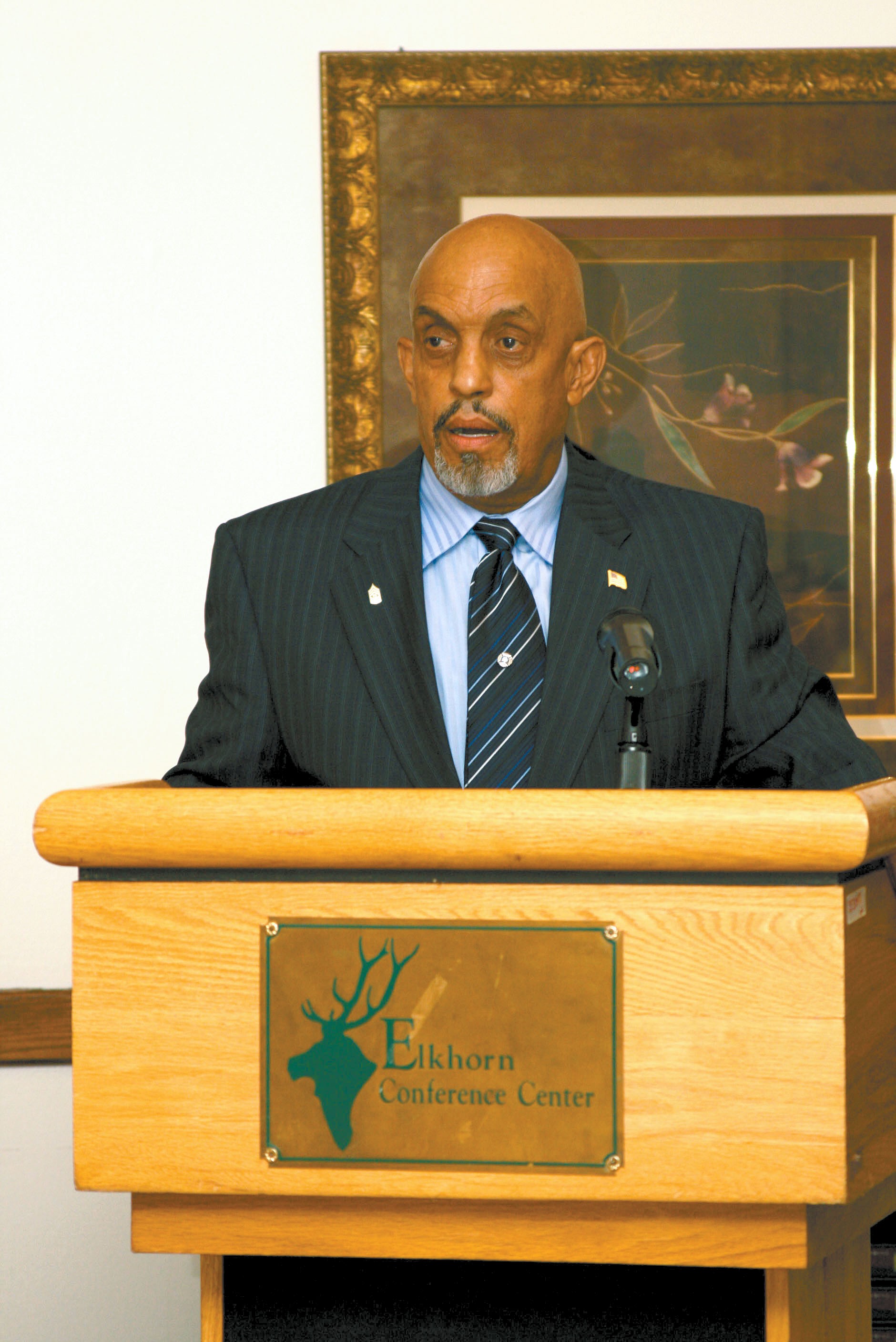
FORT CARSON, Colo.-Retired Command Sgt. Maj. Thomas Moore's Feb. 19 remarks on black history didn't highlight African-Americans who had conquered insurmountable odds to reach their dreams in the United States.
His history lesson was about two young men whose lives were cut short by hatred and racism in the heat of the civil rights movement, before the two had really begun to live.
Moore spoke to an enthralled audience at Fort Carson about the 1964 murders of his brother, Charles Eddie Moore, and friend, Henry Hezekiah Dee. Charles, a college student, and Dee were kidnapped by a group of Ku Klux Klan men in Mississippi in 1964. They were tied to trees and beaten nearly to death. When their attackers were done with the beating, they wrapped the two young men in plastic, put them in the trunk of their car and drove more than 150 miles into Louisiana. There, they dumped the two men, still clinging to life, into a river - their bodies weighted down with metal and railroad ties, said Moore, who retired from the Army as a command sergeant major at Fort Carson in 1994.
Their bodies were discovered a couple of months later when authorities were looking for three missing civil rights activists who inspired the film, "Mississippi Burning."
"Some news media had come down, because they were looking for the three civil rights workers," Moore said. "They observed and made their comments that these were not the three civil rights workers; they were the wrong bodies."
The bodies of Moore and Dee warranted very little investigation in 1964 in Mississippi. Moore, having made a promise to his mother not to do anything to those suspected of the murders, spent the next 41 years with his brother's murder eating away at him. He made a promise to his brother to bring those responsible to justice.
"I used to go to bed at night in a cold sweat," Moore said. "What possibly could have happened to Charles Moore' I didn't know."
Moore said he asked for help through the years from the National Association for the Advancement of Colored People, Jesse Jackson and Rev. Al Sharpton but never got a reply. Finally, a documentary filmmaker from Canada contacted Moore in 2005 about making a documentary about his brother's murder.
"David Ridgen had looked at this clip of the film that said these were the wrong bodies," Moore said. "It kind of put a stink under his nose, because he wanted to know why you could discriminate against not only color, but different people, because they (were not) the three civil rights workers.
"He contacted me, and asked me would I go with him to do a documentary. I said: 'Well, what's in it for me' What do you think I'm going to get out of it''
"He said: 'Hopefully, the truth.'"
That was exactly the right response to persuade Moore to participate.
"For 41 years I sought (the truth)," Moore said. "The opportunity (was here) to shake things up. Now was the time to free myself of the anger, the guilt, the frustration and shame that had kept me in chains for so long."
The documentary, "Mississippi Cold Case," was slow going and wouldn't be shown until June 2007.
Moore wanted faster results.
He decided to return to his hometown.
Moore had learned that only two of the seven men responsible for his brother's death were still alive. Just before he departed Colorado Springs for his hometown, he had seen news reports that one of those men, James Ford Seale, had died.
Moments after he arrived in Meadville, Miss., however, he learned that Seale was very much alive and confronted him, with no result.
Moore then visited the only other living suspect in his brother's kidnapping and murder, Charles Marcus Edwards, who was a church deacon.
"I walked up to him and at 10-20 feet said: 'You're Charles Marcus Edwards.' He said: 'Yes, I am. Who are you, fella''' I said: 'My name is Thomas Moore.' He said: 'I didn't kill your brother.' That's how he said it," Moore said.
In January 2007, Seale was indicted on two counts of kidnapping and one count of conspiracy. Edwards, who was granted immunity from prosecution, would be the primary witness for the prosecution.
Moore was driving to Washington D.C., to attend a Jan. 24, 2007, press conference when he got word of the indictment.
"We were going through Virginia, and the word came on my cell phone that they had indicted James Ford Seale," Moore said. "United States Federal Marshals had brought him in. I couldn't help but stop the van and cry.
"All of my pain was gone. I did all I could do. Now, it was up to the system."
On June 14, 2007, the jury deliberated for less than two hours before convicting Seale on all charges. He was sentenced to three life terms, Moore said.
Moore's speech drew a standing ovation from the hundreds in attendance at the luncheon. He was followed by performances from the Harmony in Motion singers and spirited African dancing from the Oluwaseyi dancers.
While the luncheon was both thought provoking and entertaining, the post Equal Opportunity noncommissioned officer said people don't have to wait for observances like African-American/Black History Month to learn about different cultures.
"They should interact more, attend more social functions and educate themselves," said Master Sgt. Cory Wilson, Fort Carson Equal Opportunity noncommissioned officer in charge. "Read up on someone who's not from your ethnic group, race or culture and learn more."
The audience was left with material to reflect upon, following Moore's remarks, especially the image of Moore's visit to his brother's grave after finally achieving justice in the kidnapping and murder.
"I had one more mission I had to do," Moore said. "I would visit my brother's gravesite. I stood at the foot of Charles Moore's grave. I snapped to the position of attention and gave him a salute. Mission accomplished; I did what I said I would do."

Social Sharing